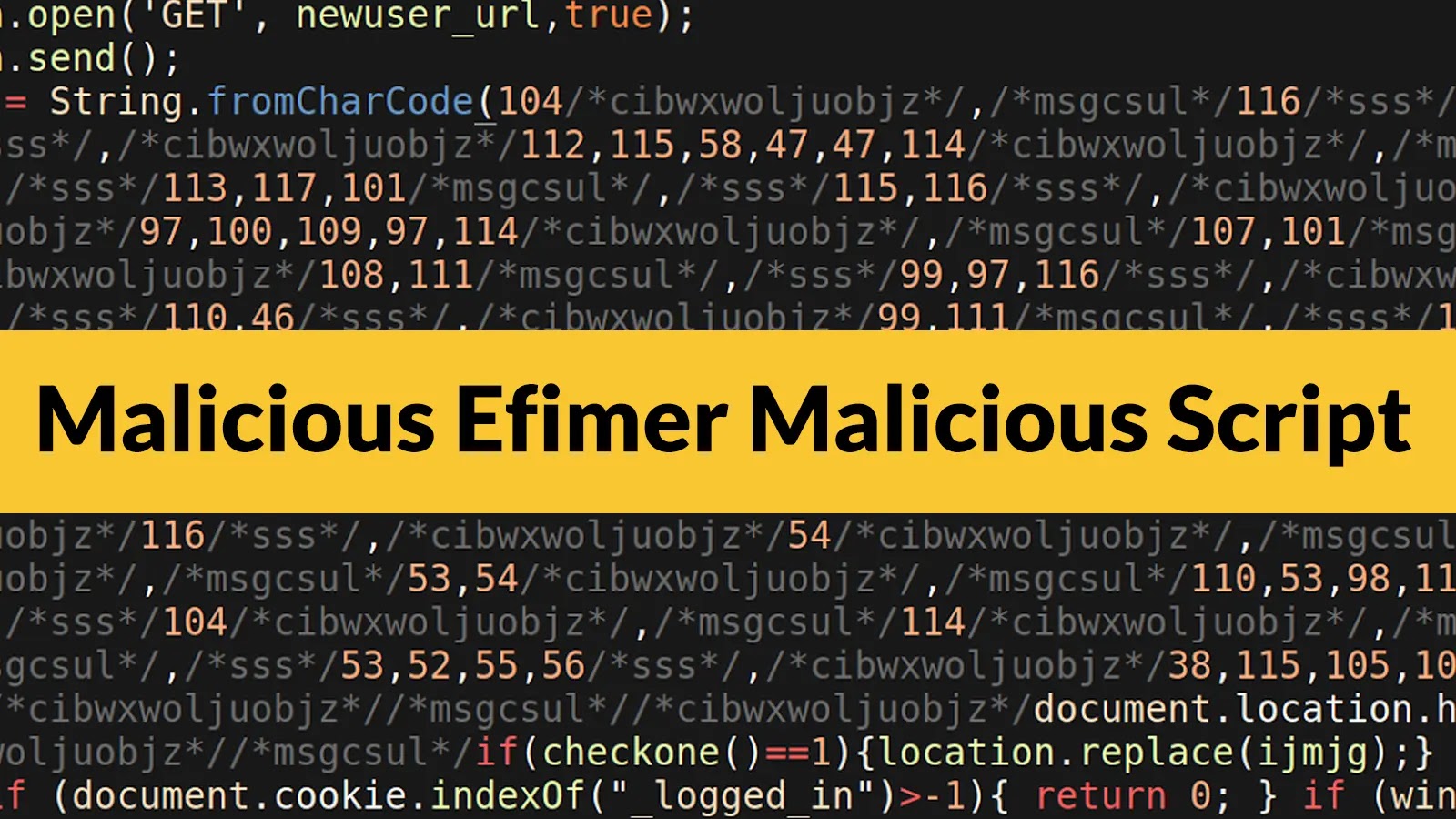
Huge Wave of Malicious Efimer Malicious Script Attack Users via WordPress Sites, Malicious Torrents, and Email
The digital landscape is under perpetual siege, with threat actors continuously refining their tactics to exploit new vulnerabilities and perpetuate established attack vectors. A recent and particularly concerning development is the emergence of a sophisticated malware campaign dubbed “Efimer.” This campaign, first detected in October 2024, represents a significant escalation in the threat to cryptocurrency users and demonstrates a worrying evolution in infrastructure and self-propagation capabilities. As cybersecurity analysts, understanding the intricacies of Efimer is paramount to safeguarding digital assets and infrastructure.
Understanding the Efimer Threat
Efimer is not a one-dimensional threat; it’s a multi-vector attack combining compromised web assets, illicit file distribution, and social engineering. At its core, Efimer functions as a ClipBanker-type Trojan. For those unfamiliar, a ClipBanker typically monitors a user’s clipboard for cryptocurrency wallet addresses. When a valid address is detected, the malware swiftly replaces it with an attacker-controlled address, rerouting intended transactions to the threat actor’s wallet. What sets Efimer apart is its elaborate delivery mechanism and self-propagating nature, significantly increasing its potential reach and impact on unsuspecting users.
Multi-Vector Attack Modalities
The success of the Efimer campaign lies in its diverse and overlapping attack vectors, ensuring a broad attack surface and higher probability of victim compromise. Security professionals must be aware of each modality to implement effective preventative measures.
Compromised WordPress Websites
A primary infection vector for Efimer involves the exploitation of vulnerable WordPress websites. Threat actors compromise these sites, injecting malicious scripts that then redirect or infect visitors. This leverages the trust users place in legitimate websites, turning them into unwitting conduits for malware delivery. The widespread adoption of WordPress makes this a highly effective distribution channel, as many sites may not adhere to rigorous security patching schedules or configuration best practices.
Malicious Torrents
Beyond compromised websites, Efimer propagates through malicious torrents. This method exploits the common practice of file sharing, particularly of pirated software, movies, or games. Users downloading these seemingly innocuous files unknowingly execute the Efimer malware, initiating the infection chain. This vector often preys on users’ desire for free content, turning a seemingly harmless download into a significant cybersecurity risk.
Deceptive Email Campaigns
Traditional but still highly effective, deceptive email campaigns form another critical component of Efimer’s attack arsenal. These emails are likely crafted to appear legitimate, employing social engineering tactics to trick recipients into clicking on malicious links or opening infected attachments. Phishing, spear-phishing, and even business email compromise (BEC) techniques could be leveraged to deliver the Efimer payload, demonstrating the breadth of the threat actors’ operational capabilities.
Impact and Evolution of Efimer
The immediate impact of Efimer is primarily financial, with cryptocurrency users facing the risk of losing their digital assets through hijacked transactions. However, the true concern lies in Efimer’s reported evolution beyond a simple cryptocurrency stealer. Its development into a “comprehensive malicious infrastructure capable of self-propagation” suggests a more advanced and persistent threat. This self-propagating capability could mean Efimer attempts to spread laterally within networks, infect other devices, or even establish persistent footholds for future attacks, escalating its categorization from a nuisance to a significant enterprise-level risk.
Remediation Actions for Efimer
Mitigating the Efimer threat requires a multi-layered security approach, combining technical controls with user education. Organizations and individuals must adopt proactive measures to protect their assets from this evolving campaign.
- Regular Software Updates: Ensure all content management systems (CMS) like WordPress, plugins, and themes are kept up-to-date with the latest security patches. This mitigates the risk of website compromise.
- Strong Password Policies and Multi-Factor Authentication (MFA): Implement complex, unique passwords for all accounts, especially those with administrative privileges on websites. Enable MFA wherever possible to add an extra layer of security.
- Email Security Solutions: Deploy advanced email filtering solutions to detect and block malicious emails, including phishing and malware-laden attachments. Train users to identify phishing attempts.
- Endpoint Detection and Response (EDR) & Antivirus: Utilize robust EDR solutions and up-to-date antivirus software on all endpoints. These tools can detect and block Efimer’s execution and prevent its self-propagation.
- Network Segmentation: Implement network segmentation to limit the lateral movement of malware in case of a breach.
- Web Application Firewalls (WAF): Deploy WAFs to protect web applications, including WordPress sites, from common web-based attacks that Efimer might leverage for initial compromise.
- User Education and Awareness: Conduct regular cybersecurity awareness training for all users, emphasizing the dangers of clicking suspicious links, opening unsolicited attachments, and downloading content from untrusted sources (e.g., malicious torrents).
- Clipboard Monitoring Tools: While not a direct remediation, some security tools offer clipboard monitoring capabilities that alert users to suspicious changes in clipboard content, potentially catching ClipBanker activity.
- Cryptocurrency Transaction Verification: Always double-check cryptocurrency wallet addresses before confirming transactions. Compare the address in your clipboard with the intended recipient’s address character by character.
Tools for Detection and Mitigation
Leveraging the right security tools is crucial in the fight against sophisticated malware like Efimer. Here are some categories and examples of tools that can assist in detection, analysis, and mitigation:
| Tool Name/Category | Purpose | Link |
|---|---|---|
| Endpoint Detection & Response (EDR) | Real-time monitoring, detection, and response to threats on endpoints. Examples: CrowdStrike Falcon, SentinelOne. | (Product Specific Links – e.g., CrowdStrike, SentinelOne) |
| Web Application Firewalls (WAF) | Protect web applications from attacks, including those targeting CMS vulnerabilities. Examples: Cloudflare WAF, ModSecurity. | Cloudflare WAF, ModSecurity |
| Email Security Gateways | Filter malicious emails, attachments, and phishing attempts before they reach end-users. Examples: Proofpoint, Mimecast. | (Product Specific Links – e.g., Proofpoint, Mimecast) |
| Threat Intelligence Platforms | Provide insights into emerging threats, attack indicators, and actor profiles. Examples: Palo Alto Networks Unit 42, Recorded Future. | Palo Alto Unit 42, Recorded Future |
| Vulnerability Scanners | Identify vulnerabilities in web applications and systems that Efimer could exploit. Examples: Nessus, Acunetix. | Nessus, Acunetix |
| Open-Source Intelligence (OSINT) Tools | For investigating suspicious domains, IP addresses, or file hashes related to Efimer. Examples: VirusTotal, Shodan. | VirusTotal, Shodan |
Conclusion
The Efimer malicious script campaign serves as a stark reminder of the escalating sophistication of cyber threats. Its multi-vector approach, combining compromised WordPress sites, malicious torrents, and deceptive email campaigns, highlights the need for a comprehensive and adaptive cybersecurity posture. For IT professionals, security analysts, and developers, recognizing Efimer’s capabilities—especially its evolution beyond a simple cryptocurrency stealer into a self-propagating malicious infrastructure—is crucial. Proactive patching, robust security controls, and continuous user education are not merely best practices; they are essential defenses in safeguarding digital assets against threats like Efimer.





